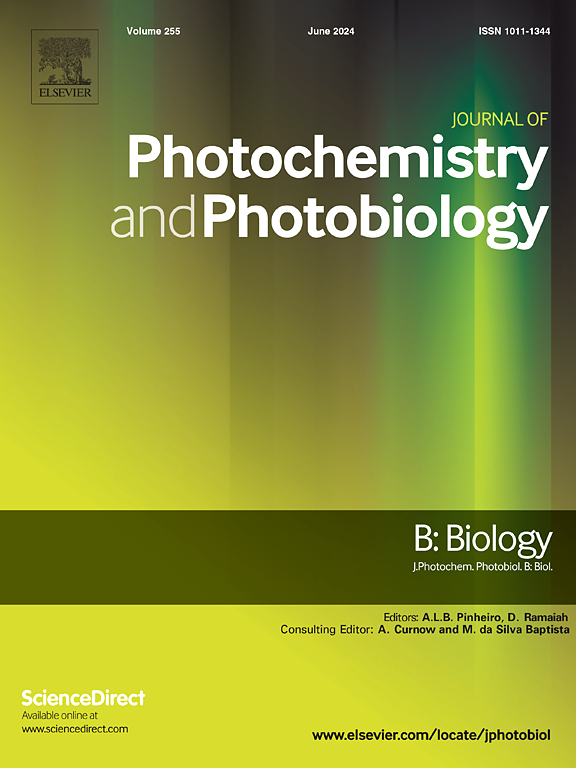Binding of collagen I to integrins alleviates UVB-caused mitochondrial disorders in human keratinocytes HaCaT through enhancement of F-actin polymerization
IF 3.7
2区 生物学
Q2 BIOCHEMISTRY & MOLECULAR BIOLOGY
Journal of photochemistry and photobiology. B, Biology
Pub Date : 2025-04-28
DOI:10.1016/j.jphotobiol.2025.113170
引用次数: 0
Abstract
Collagen I is one of the major components of the extracellular matrix in human skin, and is frequently used in skin cares and medications. Previously, we revealed that human keratinocytes HaCaT cells grown on collagen I (Col)-coated dishes gain resistance against UVB damages owing to the restored mitophagy. In this study, we further investigate the mechanisms by which collagen I modulates mitophagy. UVB irradiation causes loss of integrin β1 and collapse of F-actin cytoskeleton. Considering the requirement of actin skeleton in various cellular processes, we are curious about the participation of F-actin collapse in UVB damage. Integrin β1, whose activation enhances F-actin assembly, is a potential target for Col in UVB-treated cells. Notably, inhibiting integrin by adding an inhibitor RGDS or siRNA attenuates the effect of Col against UVB damages, confirming the participation of integrin in cell protection. The collapse of F-actin is rescued by Col, accompanying increases in the mRNA of F-actin polymerization-associated proteins and decreases in the mRNA of depolymerization-associated proteins. Inhibiting actin polymerization by using cytochalasin D represses the protective effect of Col, confirming the cytoprotective role of F-actin in UVB-treated cells. Remarkably, mitophagy in UVB-treated cells restored by Col-coating is inhibited by adding cytochalasin D or RGDS, as shown by the decreases of lysosomes, mitochondrial ubiquitin proteins, and co-localization of autophagosomes and mitochondria, resulting in accumulation of damaged mitochondria, which stresses the importance of F-actin and integrin in mitophagy. In summary, integrins and F-actin are required for mitophagy in UVB-irradiated HaCaT cells, and their enhancements by Col-coating facilitate timely elimination of damaged mitochondria caused by UVB, finally contributing to cell survival.
胶原I与整合素的结合通过增强f -肌动蛋白聚合,减轻了uvb引起的人角化细胞HaCaT线粒体疾病
胶原蛋白I是人体皮肤细胞外基质的主要成分之一,经常用于皮肤护理和药物治疗。先前,我们发现在胶原I (Col)包被的培养皿上生长的人角质形成细胞HaCaT细胞由于修复了线粒体自噬而获得了抵抗UVB损伤的能力。在这项研究中,我们进一步探讨了胶原I调节线粒体自噬的机制。UVB辐射导致整合素β1的丢失和f -肌动蛋白细胞骨架的崩溃。考虑到各种细胞过程对肌动蛋白骨架的要求,我们对f -肌动蛋白崩溃在UVB损伤中的参与感到好奇。整合素β1的激活增强了f -肌动蛋白的组装,是uvb处理细胞中Col的潜在靶标。值得注意的是,通过添加抑制剂RGDS或siRNA抑制整合素可减弱Col对UVB损伤的作用,证实整合素参与细胞保护。Col可挽救f -肌动蛋白的崩溃,并伴随f -肌动蛋白聚合相关蛋白mRNA的增加和解聚合相关蛋白mRNA的减少。利用细胞松弛素D抑制肌动蛋白聚合抑制Col的保护作用,证实了f -肌动蛋白在uvb处理细胞中的细胞保护作用。值得注意的是,添加细胞松弛素D或RGDS可以抑制经Col-coating修复的uvb处理细胞的线粒体自噬,表现为溶酶体、线粒体泛素蛋白减少,自噬体和线粒体共定位,导致受损线粒体积累,这强调了F-actin和整合素在线粒体自噬中的重要性。综上所述,UVB照射下的HaCaT细胞需要整合素和F-actin进行线粒体自噬,通过Col-coating增强整合素和F-actin有助于及时消除UVB引起的线粒体损伤,最终促进细胞存活。
本文章由计算机程序翻译,如有差异,请以英文原文为准。
求助全文
约1分钟内获得全文
求助全文
来源期刊
CiteScore
12.10
自引率
1.90%
发文量
161
审稿时长
37 days
期刊介绍:
The Journal of Photochemistry and Photobiology B: Biology provides a forum for the publication of papers relating to the various aspects of photobiology, as well as a means for communication in this multidisciplinary field.
The scope includes:
- Bioluminescence
- Chronobiology
- DNA repair
- Environmental photobiology
- Nanotechnology in photobiology
- Photocarcinogenesis
- Photochemistry of biomolecules
- Photodynamic therapy
- Photomedicine
- Photomorphogenesis
- Photomovement
- Photoreception
- Photosensitization
- Photosynthesis
- Phototechnology
- Spectroscopy of biological systems
- UV and visible radiation effects and vision.

 求助内容:
求助内容: 应助结果提醒方式:
应助结果提醒方式:


